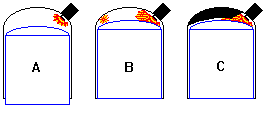
A squishband is an area in the cylinder head where the piston almost touches the head (only about 1mm space left). Modern 2-stroke engines use a compression ratio of about 14:1 to 16:1. That's not possible in a classical hemispherical combustion chamber because of detonations.
Normally, when the spark ignites the fuel/air mixture, the flame starts to move outwards and away from the sparkplug (Fig. A). The pressure and heat both rise very quickly. At very high compression in an older type engine (without a squishband) the combustion chamber is so big that the fuel/air mixture in the outer areas also starts to burn, due to the increasing temperature (Fig. B). This is known as pre-ignition. Suddenly you have two flames moving rapidly towards each other, and soon you have a detonation, making an annoying "pinging" sound. If you let the engine work that way, you soon have a nice little hole in the middle of the piston, and that's not good !

The squishband goes around the outer part of the combustion chamber very close to the piston when in top dead center (TDC) and creates a nice little hemispherical chamber - so small that pre-ignition does not have time to take place (Fig. C). The smaller chamber also lets the whole charge of fuel burn in a shorter time, which makes it possible to fire the spark closer to TDC. Mikael's engine sparks at about 17-18° before TDC, compared with 30° before TDC for an unmodified engine.